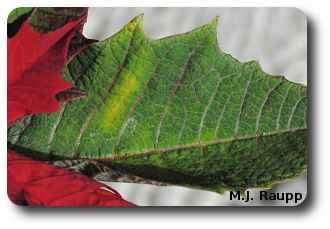Decorating the home with poinsettias is a holiday tradition that likely originated in Mexico where poinsettias are used to decorate the nativity. According to legend in the town of Cuernavaca a young girl had no flowers to adorn the nativity at her church. Instead, she collected a weed growing by the roadside. An angel transformed the weed into the beautiful poinsettia and, ever since, poinsettias have been used a seasonal decoration. Poinsettias are as much of a holiday tradition as mistletoe, holly, and an evergreen tree in many homes. As I browse displays of poinsettias that have sprung up in every hardware and grocery store, I seek the holiday whitefly.
Adult whiteflies look like tiny moths.
Whiteflies are small sucking insects and relatives of more commonly known sap-suckers such as aphids and soft scales we met in previous episodes of Bug of the Week. To spot a whitefly-infested poinsettia, first look at the color of the plant’s leaves, not the red, yellow, or speckled bracts comprising the blossom. The leaves on most varieties should be a clear deep green with no evidence of yellow patches or streaks. Leaves with yellow patches that are undersized, twisted, puckered, or curled can be a sign of holiday problems yet to come. Whiteflies are usually found on the underside of leaves where they insert tiny beaks into the plants vascular system to extract sap. Plant sap contains nutrients needed for their growth and development. Large populations can cause leaves to drop prematurely. As whiteflies feed, they excrete a sugary waste product called honeydew. This sticky liquid can become a substrate for the growth of an ugly fungus known as sooty mold.
Yellow patches on leaves may be a sign of whiteflies feeding below.
Whiteflies have four stages in their lives, egg, nymph, pupa, and adult. An adult whitefly lays eggs on the undersurface of a leaf. After several days, eggs hatch and mobile nymphs, called crawlers, move about the leaf surface until they find a suitable place to feed. Nymphs hunker down, shed their skin, and become stationary for the remainder of their youth. After one more molt, a pupa forms, and from this pupa emerges the adult whitefly. Shed pupal skins often festoon the undersides of leaves. Adult whiteflies look like tiny white moths. They too have sucking mouthparts and suck the sap of poinsettias. If disturbed, they flutter from the leaf surface. The nymphs and pupae are usually yellowish or whitish and translucent. Red eyespots can be seen on the pupa shortly before the adult whitefly emerges. For the folks that grow poinsettias, whiteflies can be a very serious problem. If populations become too great, entire crops are lost. The most common whiteflies that come home with poinsettias are the greenhouse whitefly, Trialeurodes vaporariorum, and the silverleaf whitefly depicted in this Bug of the Week. A strain of silverleaf whitefly, the dastardly “Q biotype”, has been found in several states in the US. This strain is resistant to many of the pesticides formerly used to control whiteflies and is causing headaches for the greenhouse industry. Fortunately, entomologists are finding new ways to control whiteflies using tiny wasps that attack them, predatory beetles that eat them, and pathogens that give them lethal infections. This Bug of the Week may sound a bit like the Nightmare before Christmas but if you find a few whiteflies on your poinsettia try to relax and enjoy them. If whiteflies are numerous and your poinsettia looks whipped, you may do best to toss it out and replace it.
To learn more about whiteflies, please visit the web sites listed below.
http://insects.tamu.edu/fieldguide/aimg97.html
http://creatures.ifas.ufl.edu/veg/leaf/silverleaf_whitefly.htm


